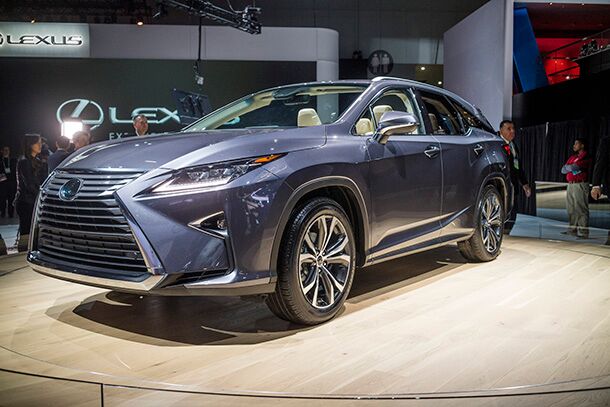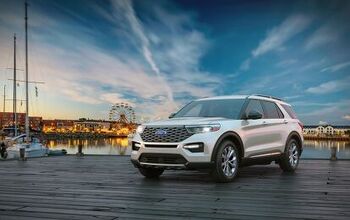Toyota Gaining Ground in Quest for More Light Truck Sales

January was a boffo sales month for Toyota in the United States, with the automaker posting a 16.8 percent year-over-year increase across both the Toyota and Lexus brands. Toyota brand sales rose 17 percent, to the luxury division’s 15 percent.
Don’t expect that kind of growth to continue, says Jack Hollis, Toyota North America’s general manager, as the industry still expects a slump in 2018. More important to Toyota than last month’s sales, however, is the type of vehicles Toyota buyers actually took home. In this case, brand loyalists added crossovers, SUVs, and trucks to their driveway in greater numbers than ever before.
The record set for Toyota light truck sales in the U.S. last month was exactly what the company was hoping for. Still, keeping that truck-buying momentum going is now job one.
Toyota came closer than ever to fixing a persistent product problem last month. As more and more buyers gravitate towards SUVs and trucks, Toyota soon found itself lagging behind the industry average in terms of its cars-to-trucks ratio. Cars — a rapidly shrinking segment — made up too much of Toyota’s sales. Hardly a good way to face the future.
But there’s progress being made on this front. Speaking to Automotive News, Hollis said that over the last four months, American buyers chose light trucks over passenger cars by a ratio of 64:36. Toyota ended 2017 with a sales mix of 58:42. A year earlier, just 53 percent of the company’s U.S. sales were light trucks. In January, however, Toyota cleared the 60 percent bar for the first time, pushing it closer to the industry average (where, presumably, safety lies).
“As we see that, we are gaining more of what the industry is selling,” Hollis said, giving some of the credit for last month’s sales surge to the growing popularity of certain models.
While Toyota brand cars saw a year-over-year sales uptick of 5.7 percent in January, demand for Lexus cars fell by 2.3 percent. Toyota pickup sales rose 27.3 percent, year over year, with growth in Tacoma sales amounting to 33.6 percent. The same trend carried over in Toyota’s SUV division, where sales climbed 26.7 percent compared to the previous January. Only old, low-volume models (Sequoia, Land Cruiser) saw any decrease in sales.
At Lexus, sales of the NX, LX, GX, and RX lines rose a combined 23.6 percent. As we’ve seen recently, Toyota’s pulling out all the stops to make its light truck lineup more appealing to buyers. Besides adding the subcompact C-HR crossover to the stable, the automaker introduced a longer, three-row RX and cheaper, two-row LX, with an improved line of TRD Pro off-road models also on the way. Later this year, we’ll see the redesigned RAV4 — a model already in possession of the “best-selling crossover” title.
Despite earlier efforts to squeeze more Tacomas out of its Texas and Mexico assembly plants, Toyota plans to feed the demand with additional production in the near future.
Actually, it’s likely Toyota would already have reached the industry’s 64:36 truck-to-car ratio, were it not for two names: Camry and Corolla. Those two cars, backed up by decades of name recognition and a solid reputation, continue selling well. Suffice it to say, there’s far worse situations an automaker could find itself in.
[Images: Toyota]

More by Steph Willems
Latest Car Reviews
Read moreLatest Product Reviews
Read moreRecent Comments
- Honda1 Unions were needed back in the early days, not needed know. There are plenty of rules and regulations and government agencies that keep companies in line. It's just a money grad and nothing more. Fain is a punk!
- 1995 SC If the necessary number of employees vote to unionize then yes, they should be unionized. That's how it works.
- Sobhuza Trooper That Dave Thomas fella sounds like the kind of twit who is oh-so-quick to tell us how easy and fun the bus is for any and all of your personal transportation needs. The time to get to and from the bus stop is never a concern. The time waiting for the bus is never a concern. The time waiting for a connection (if there is one) is never a concern. The weather is never a concern. Whatever you might be carrying or intend to purchase is never a concern. Nope, Boo Cars! Yeah Buses! Buses rule!Needless to say, these twits don't actual take the damn bus.
- MaintenanceCosts Nobody here seems to acknowledge that there are multiple use cases for cars.Some people spend all their time driving all over the country and need every mile and minute of time savings. ICE cars are better for them right now.Some people only drive locally and fly when they travel. For them, there's probably a range number that works, and they don't really need more. For the uses for which we use our EV, that would be around 150 miles. The other thing about a low range requirement is it can make 120V charging viable. If you don't drive more than an average of about 40 miles/day, you can probably get enough electrons through a wall outlet. We spent over two years charging our Bolt only through 120V, while our house was getting rebuilt, and never had an issue.Those are extremes. There are all sorts of use cases in between, which probably represent the majority of drivers. For some users, what's needed is more range. But I think for most users, what's needed is better charging. Retrofit apartment garages like Tim's with 240V outlets at every spot. Install more L3 chargers in supermarket parking lots and alongside gas stations. Make chargers that work like Tesla Superchargers as ubiquitous as gas stations, and EV charging will not be an issue for most users.
- MaintenanceCosts I don't have an opinion on whether any one plant unionizing is the right answer, but the employees sure need to have the right to organize. Unions or the credible threat of unionization are the only thing, history has proven, that can keep employers honest. Without it, we've seen over and over, the employers have complete power over the workers and feel free to exploit the workers however they see fit. (And don't tell me "oh, the workers can just leave" - in an oligopolistic industry, working conditions quickly converge, and there's not another employer right around the corner.)
































Comments
Join the conversation
So Toyota's upping their game in the light truck segments, while increasing passenger car sales in the face of declining sales in that segment. Shocker. The only segments Toyota hasn't mastered are the full-size Pickup and SUV segments. They have entries, but the domestic brands still own these segments. I don't see that situation changing anytime soon.
GM, Ford & FCA had better watch their backs, as Toyota is sneaking up with their trucks. Some love them, others won't go near them, but whoever proves their product reliability is best, they may win in the long run. Me? I still prefer GM, but not like I used to. Being retired, I've bought my last new car, and whatever I replace my 2012 Impala with is anybody's guess. Many preach the gospel of Toyota, but their products simply don't "speak" to me. Who knows? Time will tell.